Arugula has become one of the popular vegetables in many recipes around the world. This vegetable has high nutritional content as well as vitamins to maintain human health. The spicy and intense flavor of Arugula vegetables is very special, so they have become one of the indispensable ingredients in many salads, pizzas, or sandwiches.
Gardeners often plant Arugula seeds indoors to ensure the ideal environment for the seeds to germinate. However, a problem that many people ask is the appropriate time to transplant Arugula seedlings to the outside environment. When to transplant arugula seedlings? What principles should you keep in mind when carrying out the seedling transplant process? How do you determine the best time to transplant Arugula seedlings? Join us to learn the details in this article.
When To Transplant Arugula Seedlings
The best time to transplant Arugula is when they are about 2-3 inches tall and have at least two new leaves (Not the first cotyledon). In addition, Arugula seedlings need to be familiar with the outside environment to adapt before transplanting them directly into the ground.
Arugula is often grown in containers or hydroponically indoors. However, you can still grow them outdoors and harvest vegetable leaves with a special flavor. After you plant Arugula seeds in nursery trays, they will begin to sprout within a few days if soil conditions are moist and temperatures are warm. Arugula seedlings will continue to grow rapidly during this period.
Arugula seedlings will have soft, weak stems, shallow roots, and one or two cotyledons. At this stage, young trees are very weak so they are easily affected by negative effects of weather such as high winds, heavy rain, or frost. Therefore, you need to ensure the ideal living environment for the seedlings by providing ideal water, light, and humidity. When the Arugula seedlings are about 2-3 inches tall and sturdy, you can begin the process of transplanting them to the outside environment.

Inspect Arugula Seedlings Before Transplanting
Checking young plants before transplanting them into the ground is one of the most important factors in determining the survival rate of seedlings. Seedlings can grow very well in nursery trays or foam containers indoors. However, they can also die all at once or wither when transplanted into the ground within just a few hours. Therefore, you need to note some information below about seedlings before transplanting.
- Make sure the seedling has reached 2-3 inches in height and has at least two new leaves.
- You should not leave the seedlings too long because they may break or become weak when planted in the ground.
- For the seedlings to adapt to the temperature and outside environment, you should place the seedlings outside for 15 minutes every day. Then, you add another 30 minutes, 1 hour, 2, or 3 hours to let the seedlings gradually adapt to the outside environment.
- The time for seedlings to adapt can last from 1 to 2 weeks depending on the level of plant development.
- Choose a location that gets about four hours of warm sunlight each day and cool shade in the afternoon.
- Do not place the seedlings in an area with strong, continuous sunlight because the seedlings will wilt.
- Make sure the area where the seedlings are placed is not exposed to strong winds because the stems of Arugula seedlings are still very weak and can easily break.
Read this post: When To Harvest Arugula Seeds
How To Transplant Arugula Seedlings Into The Ground?
After you have acclimated the Arugula seedlings to the outside environment, you will transplant the seedlings into the ground when temperatures are warm. Below are the steps and notes that you need to pay attention to.
- Improve soil to maintain ideal moisture, fertilize, and add nutrients.
- Dig each small hole and place the seedling in the hole, burying the soil to cover all the roots of the seedling.
- Do not place the seedling too deep into the hole because it will affect the growth rate of the Arugula.
- You should gently pull out the seedling and transplant it into the ground to avoid breaking the roots or breaking the stem.
- Once you have transplanted the seedling into the ground, water it to maintain moisture.
- You should transplant seedlings at cool temperatures such as early morning or late afternoon to avoid the heat shock of Arugula.
- If the area where you plant the seeds has too much sunlight, you should use a trellis or take advantage of the shade from the fox trees to prevent the Arugula leaves from burning.
- You need to monitor and care for Arugula in the following days to water or provide appropriate sunlight.
- Once the roots of Arugula seedlings have attached to the soil, they will quickly absorb nutrients and grow leaves.
Summary
Arugula is a vegetable with a special flavor and is often used as an ingredient in many dishes, especially salads. You can grow Arugula indoors by sowing seeds in nursery trays or containers. However, you can still improve the yield of this vegetable by transplanting the seedlings into the ground in an outdoor environment.
Before transplanting seedlings into the ground, you need to check the quality of the seedlings. A seedling that is 2-3 inches tall and grows at least two new leaves will be good enough to start a transplant. You need to let the potted seedlings get used to the outside environment by placing them in a sunny and cool area. Once you have transplanted the seedlings into the ground, monitor them for 1-2 weeks to water, supplement nutrients, and protect them from high winds, rain, high temperatures, or frost.